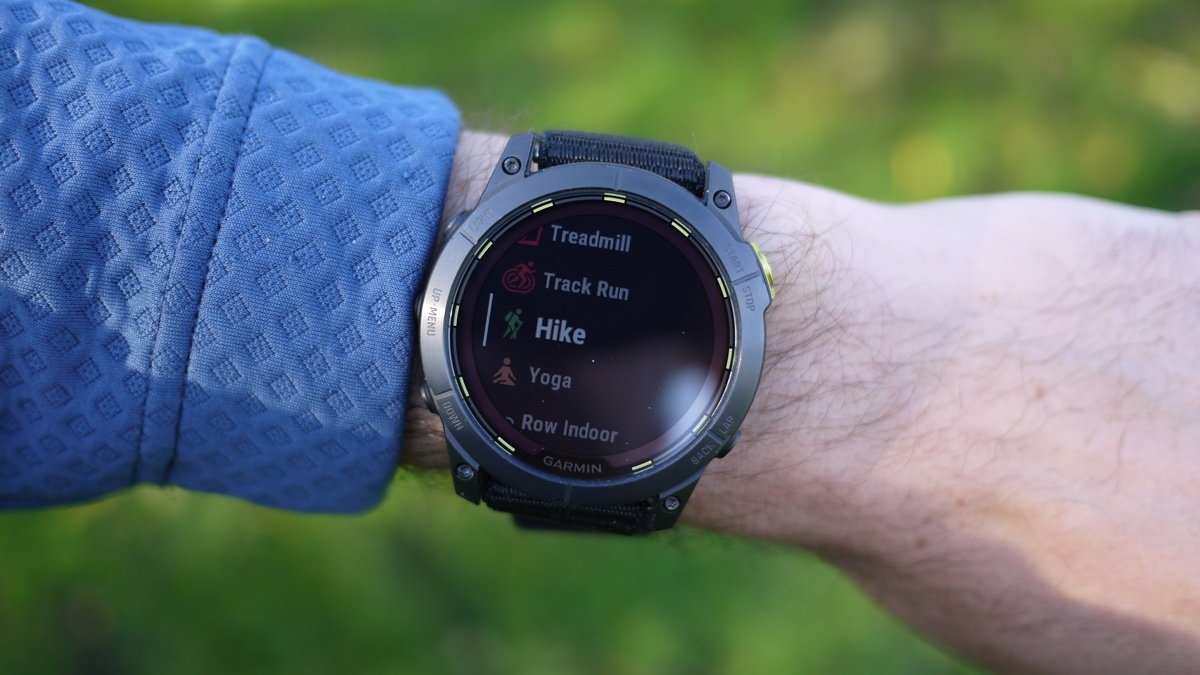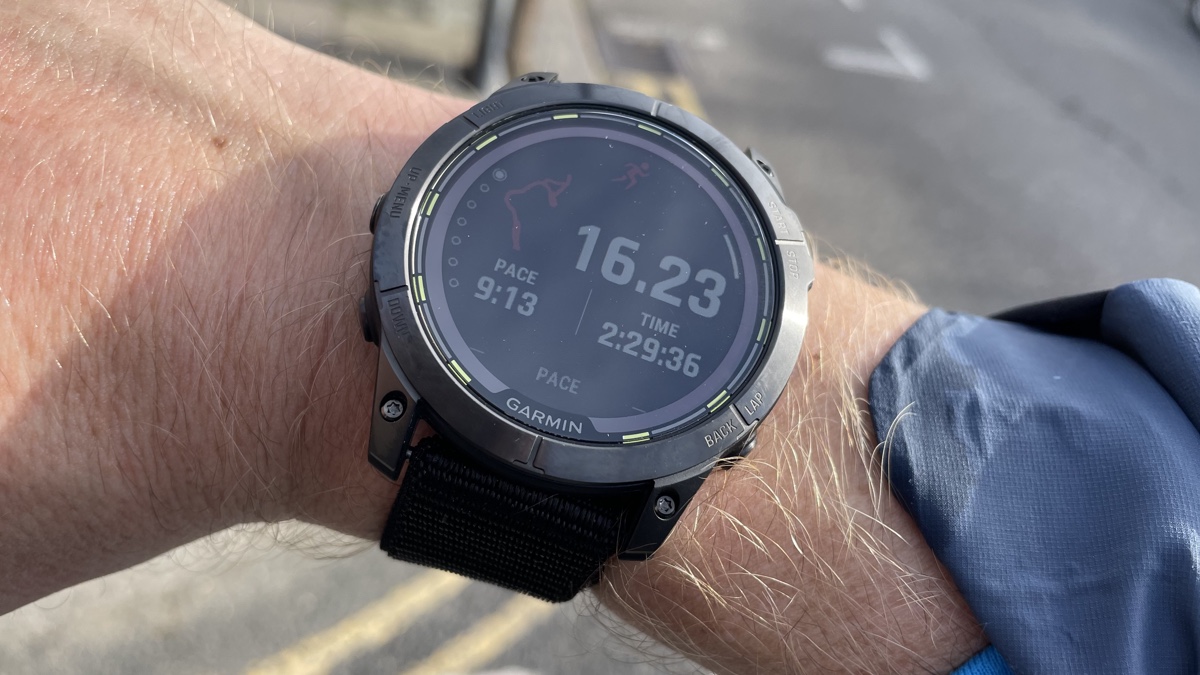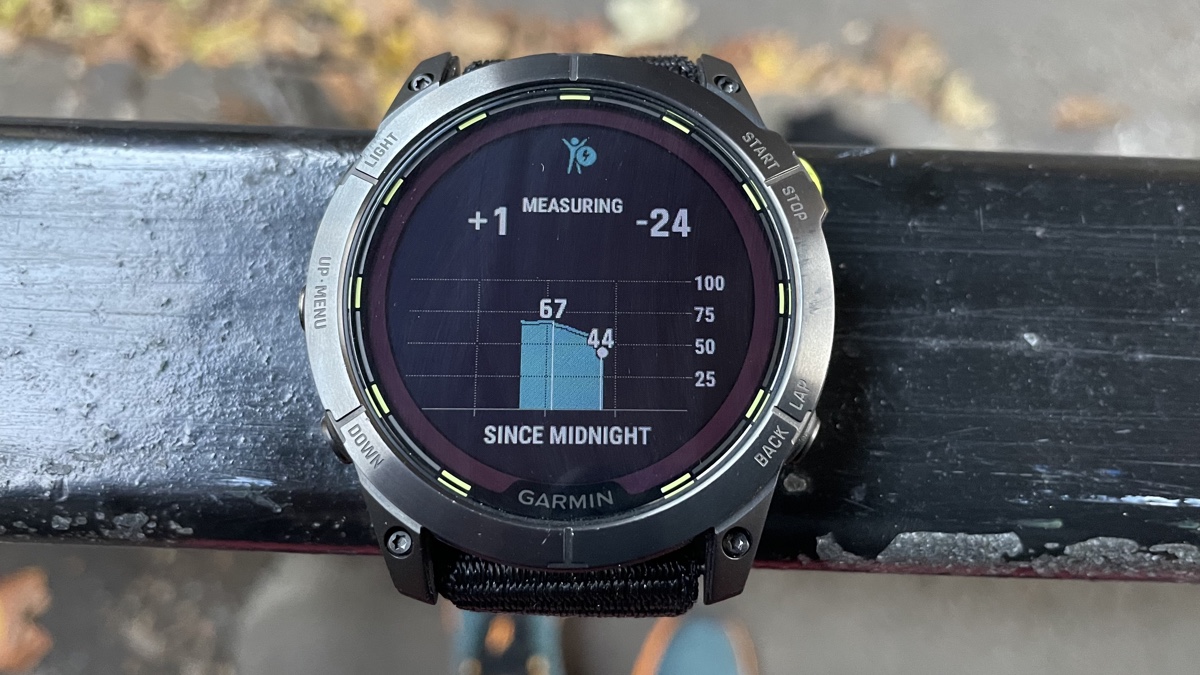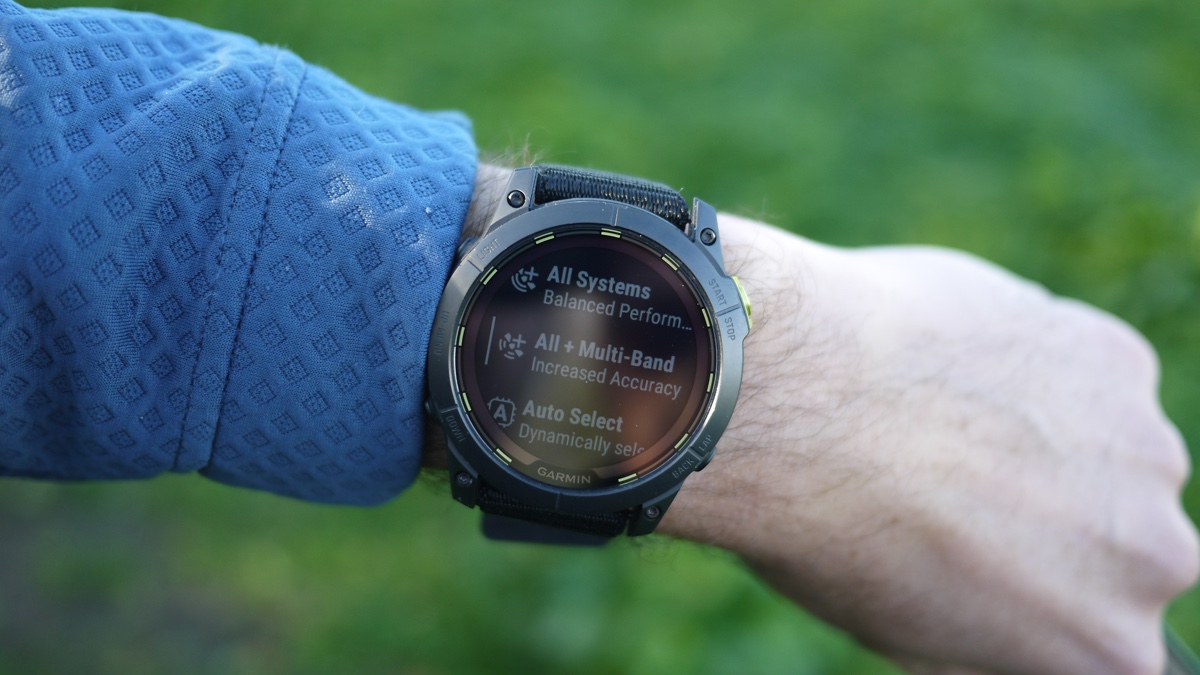
- Unrivalled battery life
- Boosted nav smarts with TOPO maps
- Offline music
- Only one size
- No AMOLED
- Got pricier
With a 110-hour GPS battery life, a new touchscreen, TOPO maps, offline music and an LED flashlight, the Garmin Enduro 2 now not only looks like a Fenix, it packs all the smarts of Garmin’s flagship too.
But all those new smarts come with a price premium. It’s a chunk more expensive than the first-generation Enduro, which started (in stainless steel) at £699 / $799 (and can now be found for £549).
At £929.99 / $1099.99, the titanium-only Garmin Enduro 2 is now one of the most expensive adventure sports watches on the planet.
Only the Fenix 7X Solar Sapphire, the Garmin Epix 2 Sapphire ($1099/£999.99), and the MARQ series cost more. Five Fenix 7 Solar editions come in as cheaper alternatives. And that’s not something we say often.
So is this beast of multi-sport endurance watches worth the investment? Has it replaced the Fenix as the new king of Garmin’s ultra-endurance line-up? Does it live up to that huge battery billing?
We put it to the test in our Garmin Enduro 2 review – and don't forget to read our best Garmin buying guide.
Battery life

Let’s start with the headline-grabbing battery life. If the original Enduro raised the bar on battery life, the Enduro 2 pushes it higher still.
Garmin claims the Enduro 2 boasts 110 hours of GPS battery life and up to 264 hours in max battery mode.
That rises to 150 hours of GPS and a whopping 714 hours Max Battery (with a low GPS sampling rate only suited to hiking or extreme endurance running) if the Power Glass solar display is exposed to constant sunlight.
Claimed general smartwatch usage is 34 days (46 with solar). That’s a drop from the first-gen Enduro which offered 50 days. But there’s an increased lifespan in Expedition mode which now stretches to 77 days – rising to 172 days when the sun plays nice.
There are five preset workout power modes to choose from, plus the option to create and store your custom settings in the really handy Power Manager tool.
It tops the Fenix 7X Solar’s 89 hours of full GPS and 213 hours in max battery mode.
Only the Coros Vertix 2 offers a longer GPS lifespan of 140 hours and 240 hours in UltraMax low-power mode.
Battery life testing results

In our tests, we got 11 days of usage on a single charge. That included 13.5 hours of training, covering a mix of indoor sessions and outdoor GPS-tracked workouts in various power modes.
By comparison, the first-gen Enduro latest 31 days on a single charge with more than 30 hours of training.
On average, in an hour’s running using All Systems GPS training the Enduro 2 burned no more than 1%.
In a 3-hour run using All Systems GPS mode, it burned 6%. That's the same as the Garmin Fenix 7X. That equates to around 50 hours of standard GPS use when Garmin states 78 hours.
There are some quirks when estimating and extrapolating battery life over long periods – but it's clear the Enduro 2 does have serious staying power.
A 2.5-hour bike ride in Extended Mode (GPS only) leeched only 4%.
The battery burn rate averaged 1% overnight without the Pulse Oximeter.
To put the Enduro 2’s battery life into context, using the right power modes to track your efforts, it’ll happily survive most week-long multi-day endurance challenges. Plus it has enough gas in the tank to cover a month-long streak for anyone running, riding, or swimming for an hour a day.
Most people will potentially only need to charge the Enduro a dozen times a year and your Enduro 2 can be on less than 5% and still head out for a two-hour ride with confidence.
The icing on the battery life cake is Garmin’s Power Manager tool. This lists estimated energy savings by sensors and features so you can see what costs the most energy and adjust accordingly. You can also create and store custom power modes to extend the battery life.
Build, case and comfort

The Enduro 2 also now only comes in one flavor – the scratch-resistant Diamond-Like Carbon (DLC) coated titanium version with a fiber-reinforced polymer case and titanium rear cover. After a month of testing, ours still looked brand new. That accounts for the higher starting price, but overall it's good news. The Enduro stainless steel was far too cumbersome and uncomfortable in our testing.
Put the new Enduro 2 next to its predecessor (or the Fenix 7 and Epix 2 for that matter) and you’ll have to look closely to tell them apart.
There are some small differences in the styling details: the dummy crown main button is now a regular button, the lime green detailing has vanished from inside the bezel and the optical sensor set-up has changed to match the Fenix 7.
Overall this is a good-looking watch that hasn’t strayed from the original Enduro design. It features the same rugged build, the same low-res color 280 x 280 transflective LCD screen, and the same chunky 51mm case.
It’s a touch fatter and marginally heavier than the original titanium Enduro (61g). At 70g it’s closer to the old 71g steel version.
Despite being lighter than the Fenix 7x (89g), there’s no escaping this is a big watch. And it’ll swamp some smaller wrists. That heft means it’s not the most comfortable to wear in bed even for the chunkier wristed. But you kind of get used to it over time and you’ll need to make the most of the sleep tracking and overnight recovery insights.
The Enduro 2’s 1.4-inch always-on color screen is big and the visuals are crisp. Not as wow as the AMOLED on the Epix 2 but it’s now also a nicely responsive touchscreen – just like you find on the Fenix 7.
The Enduro 2 screen now has sapphire lens glass, replacing PowerGlass on the original.
Like the original, the screen gets brighter in sunlight to help legibility and we found it easy to read on the move with room for up to six customizable metrics on a single screen. Those can be easily changed on the watch too. No app faffing is required.
The Enduro 2 also now sports a multi-LED flashlight building on the top edge of the case. Garmin says it’s twice as bright as the one you find on the Fenix 7X and while we wouldn’t want to rely on it while moving at speed, it’s excellent for camping and other situations where you might fire up your phone torch.
The Enduro 2 ships with a very comfortable 26 mm nylon strap and 26mm silicone watch band.

The Enduro 2’s robust frame houses a full suite of sensors including the same Elevate optical heart rate on the Fenix 7, a barometric altimeter, compass, gyroscope, and thermometer plus a SpO2 pulse oximeter for monitoring blood oxygen saturation. There’s Bluetooth and ANT+ connectivity which means you can hook up to third-party trainers like Wattbike and Peloton while simultaneously using a chest strap.
The controls are standard Garmin fare with five easy-to-use buttons that are nicely responsive, easy to use on the move, and come with plenty of shortcuts. Plus you now have the added convenience of that touchscreen which makes scrolling your post-workout stats easier. The touchscreen was nicely responsive though wet and sweaty conditions had us back using the buttons pretty quickly.
There’s a slightly smaller memory for workout history, down on the first-gen Enduro from 64GB to 32GB but still in line with the Fenix 7.
Like the Fenix 7 and Epix 2, it’s also waterproof up to 100 meters.
Sports tracking and features

The Enduro 2 follows in the footsteps of the first-gen but plugs some of the gaps. This is an excellent all-rounder that marries a huge range of sports tracking modes with performance, fitness, and recovery tools plus it now offers a stronger suite of navigation and safety features.
There are dedicated activity modes for all manner of sports including running, cycling, indoor biking, swimming (indoor and open water), skiing, surfing, mountain biking, hiking, strength training, and triathlon. Golf is well served, too and there’s a new adventure racing app.
As you’d expect on a watch at this price, it also boasts all the daily activity, sleep, stress, breathing health, and wellness tools we’ve come to see as standard fare on Garmin devices. That includes hydration logging and menstrual cycle tracking which now come with a Garmin IQ widget.
Running tests

When it comes to running, there are profiles for running, treadmill running, indoor track running, trail running, ultra running, and virtual running.
There are clever endurance skills for off-road ultra trail types too. An ultra run mode with a clever automatic rest timer that clocks when you stop and splits out how long you spend dawdling at aid station buffets.
We spent considerable time with the Enduro 2 on long-distance trail runs and did find some quirks.
The automatic timer was a bit trigger-happy. We found it started the rest timer a little too eagerly for even the briefest of pauses. But you can switch that off and the manual timer is really easy to use – essential for 75km jelly brain – and very revealing.
Post-run, you get your active heart rate and cadence separated from your normal stats.
Trail VO2 Max estimates take into account the fact that runners who hit the trail can find the slower pace hammers their VO2 Max and adjusts their VO2 Max accordingly. It’s hard to validate the accuracy of these estimates without some expensive mobile oxygen exchange gear but these can serve as a useful way to benchmark your progress, particularly if you venture off-road.
It’s worth noting that the trail-adjusted VO2 Max also works with ultra-run mode. So you can have rest times and adjusted VO2 Max if you select ultra mode.

Garmin’s excellent ClimbPro feature covers descents as well as ascents to create a full picture of the quad-burning that awaits you on your preloaded courses. That includes real-time information on the current and upcoming climbs and descents with gradient, distance, and elevation gain/loss.
The brilliantly responsive auto climb feature also flicks the watch face to show your current climb stats. It’s a very handy tool for torturing/motivating yourself during lumpy races.
The familiar training load, training effect, and training status all feature, along with a post-run recovery advisor that tells you how long it’ll take before you’re fully restored to go again.
For racers who need help pacing there’s PacePro that serves up real-time, grade-adjusted pace guidance during your run, based on the elevation and your pacing preferences. There’s also Grade Adjusted Pace and a Visual Race Predictor that now charts a 4-week trend that shows how your training is having on your potential race time.
Cycling and MTB
The Enduro 2’s cycling capabilities are in-sync with the Fenix 7, too. There are specific modes for bike, road bike, MTB, gravel bike, cyclocross, cycle commuting, bike touring, eBike, eMTB, indoor bike, and triathlon.
The Enduro 2 happily pulls data from third-party power meters, stationary bikes, and cadence sensors.
Mountain bikers can monitor the difficulty and technicality of MTB trails, with specialized grit and flow data. The Enduro 2 also remembers MTB trails and scores your performance, so you have something to beat next time out.
Swimming
The Enduro 2’s swim smarts are comprehensive. All the important lengths, distance, pace, and stroke count are covered, as is automatic stroke detection, SWOLF swims score, drill logging, pace alerts, critical swim speed, and underwater wrist-based heart rate.
In our tests, doing 500m in a 25m pool, the auto lap tracking was a single length out. But then so was the Fenix 7.

Skiing
Skiing is well served too. There are preloaded SkiView maps for more than 2,000 runs with view run names and difficulty ratings. Use the Enduro 2 with an HRM Pro Plus chest strap and you also get the exercise load of your cross-country workouts.
Suggested workouts
Garmin’s Suggested Workouts tool uses your recent training schedule and recovery status to recommend workouts to boost general fitness and avoid overtraining.
They’re sometimes useful if you’re not sure what to do on any given day and need a bit of inspiration but we found these often contradicted the feedback coming from our training insights. It’d often advise low-intensity workouts when our training status suggested we were lacking higher anaerobic work.
Though we found the same on the Enduro and the Fenix 7x so this isn’t watch-specific.
Strength training
The Enduro 2 also has a dedicated strength training mode with auto rep counting for gym goers. We’ve tested this feature across many of the more recent Garmin watches and it picks up certain gym drills like weight squats, well, it struggles with many others. Unsurprisingly single-arm moves are troublesome. It’s fairly easy to edit your reps, weights, and moves on the fly but it’s not quite the killer app just yet.
Safety features
Garmin sets the benchmark for its safety features and the Enduro 2 offers the full complement: Live track, group live tracking, live event sharing, and incident alerts during activity and assistance alerts.
Heart rate accuracy

The Enduro 2 carries Garmin's latest generation Elevate heart rate sensor tech – the same you’ll find on the Fenix 7 – with 24/7 continuous tracking that powers fitness features like Body Battery energy monitor, advanced sleep monitoring, and stress tracking.
It also provides the BPM readings for VO2 Max, heart rate zone training, and heart rate alerts and broadcasts over Bluetooth and ANT+. You can, of course, pair a chest strap for improved accuracy.
The Enduro 2’s optical heart rate sensor performed pretty well across the majority of our test runs and rides. We put it up against the Garmin HRM-Pro Plus, a Fenix 7x, the Apple Watch Ultra, and the Suunto 9 Peak Pro.

We did a mixture of long, steady low intensity runs, uptempo intervals, a half and full marathon race test, and progression rides on the Wattbike. Plus strength training sessions, 5-a-side football, and the odd HIIT Bootcamp workout.
More often than not, the optical sensor matched the HRM Pro Plus chest strap average and max heart rate readings beat for beat. During our marathon and half marathon tests, where we ran at a pretty consistent pace, there were no crazy anomalies compared to the chest strap.
Even during the interval sessions, we didn’t see the common lag and lurch that comes with optical heart rate. It did sometimes read a little higher in real-time than our chest strap and we’d always recommend using a chest strap to ensure all those training analytics and recovery insights are as accurate as possible.
The daytime readings were also roughly in line with other wrist-based heart rate monitors. And our resting heart rate tests matched the chest strap.
Activity and health

Garmin’s suite of activity and health-tracking tools is now very strong. In addition to the usual daily step count, 24-7 heart rate, and sleep tracking, there are stress estimates, Body Battery energy levels, breathing rate, and SPO2 blood oxygen.
A new health snapshot tool uses a 2-minute test to measure resting heart rate, breathing rate, stress, and blood oxygen and provide a quick one-screen overview of your key stats at any point, including your heart rate variability (HRV).
Speaking of which, the Enduro 2 now tracks average HRV overnight to give you a 7-day average and how the last night compared.
There’s also a fitness age tool that estimates where you’re at compared to your actual time spent on planet earth. It clocked me at 36 years (I’m 44) so obviously, it’s incredibly accurate.
GPS accuracy

The Enduro 2 boasts multi-band GNSS tracking with GPS, GLONASS, and Galileo. New SatIQ™ technology powers an AutoSelect mode that dynamically determines the best GPS mode to maximize battery life without compromising accuracy.
There are various ways to track including GPS only, GPS + multi-systems and a power-saving UltraTrac mode.
In our tests, the Garmin Enduro 2 GPS accuracy was reliably accurate. Over multiple distances, durations, and locations, up against the Fenix 7x, Suunto 9 Peak Pro, Apple Watch Ultra, and officially measured race routes.
Over the marathon distance during an official race, it clocked 26.34 miles to the Suunto’s 26.33 and the Fenix 7x’s 26.36.
We put the Enduro 2 in Extended mode, up against the Fenix 7x in max accuracy mode, the Suunto 9 Peak Pro, and Apple Watch in their highest accuracy modes. Over a 3-mile-ish twisty, looped park course and it read just 0.06 of a mile longer than all three.
In UltraTrac mode it was a little less on the money but still pretty solid, clocking 4.10 miles to the Fenix 7’s normal mode 3:99.
But in reality, the full-power GPS battery life is so good that you may rarely need to use the lower-power modes.
Navigation Features

The navigation options on the first-gen Enduro were as rich as most of the competition but the inclusion of multi-continent TOPO maps makes the Enduro 2 a much more fully rounded ultra adventure device.
That’s backed up by breadcrumb turn-by-turn navigation with the ability to create, load, and follow routes, plus point-to-point, back-to-start, and track-back tools.
Plus a couple of helpful new features. NextFork shows the distance to the next trail intersection as well as the name of the upcoming trial. While Up Ahead offers an at-a-glance view of selected places of interest and key trail points coming up ahead, along with performance metrics, split times, and distance/elevation.
In terms of elevation stats, the Enduro 2’s barometric altimeter is there to boost accuracy.
Smartwatch Skills
The Enduro 2’s smartwatch features are strong. The major omission on the original Enduro has been fixed with the addition of offline music and storage for up to 2,000 songs from Spotify, Deezer, and Amazon Music. You can connect your Bluetooth headphones directly and run phone-free. That also supplements the basic music controls for your paired smartphone.
You also get smartphone notifications (with text response if you’re on Android), Garmin Pay contactless payments and weather, plus access to additional apps, tools, faces, and widgets via Connect IQ.
How we test
